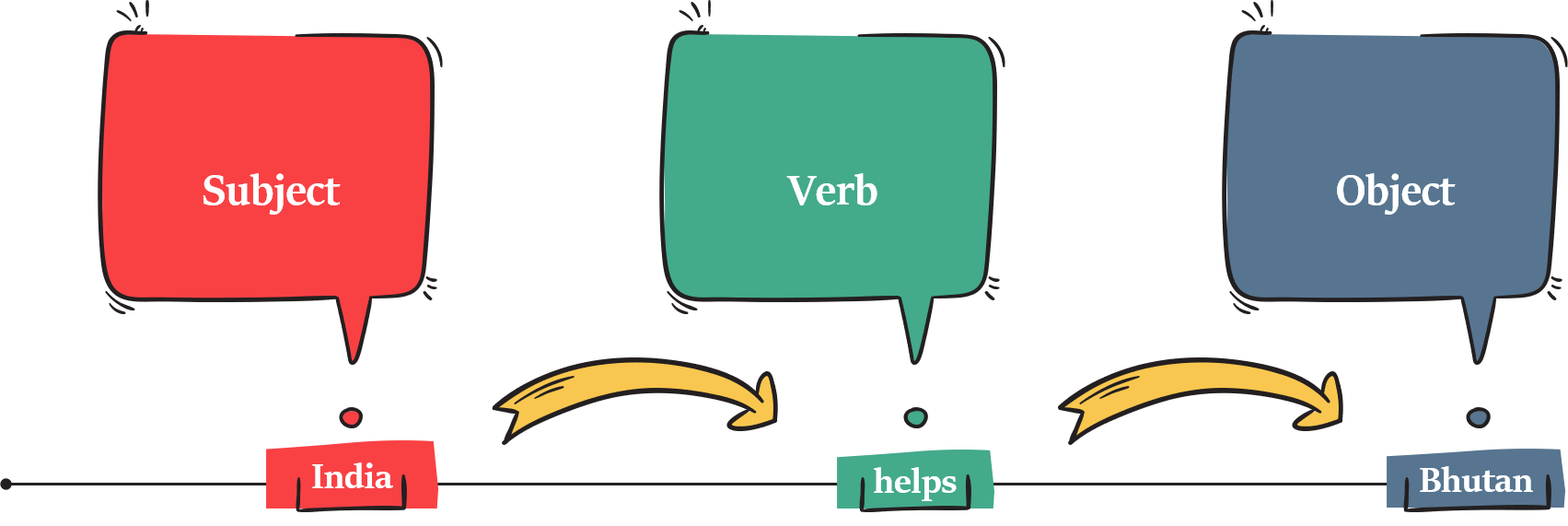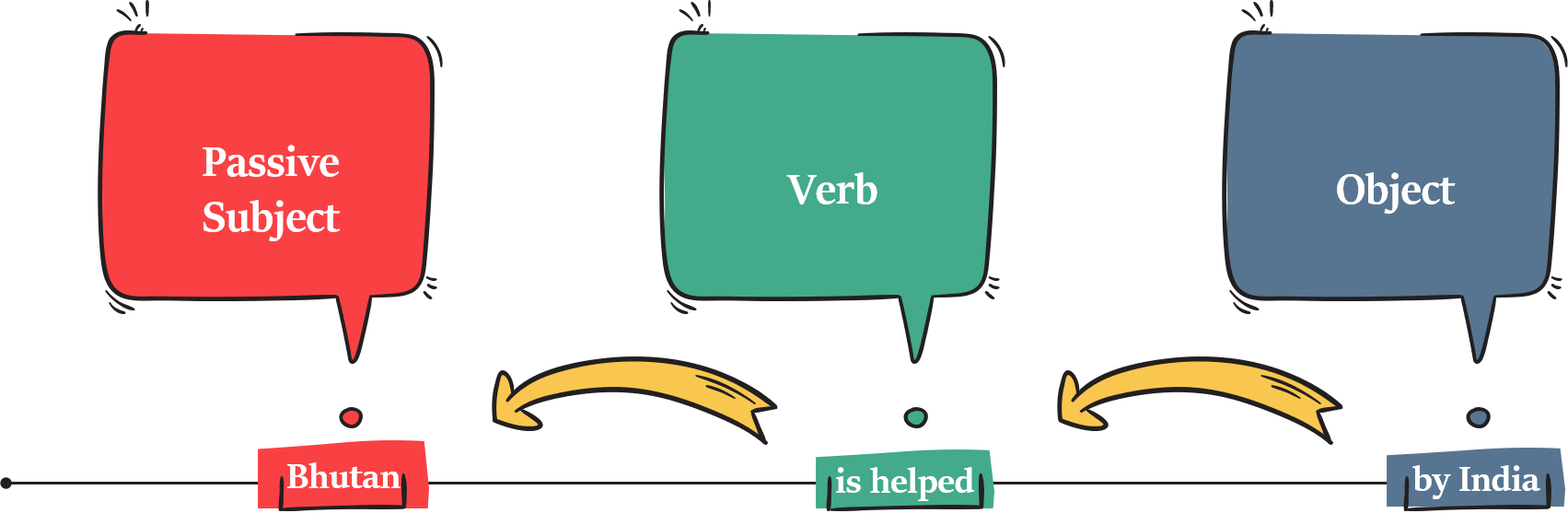Transformation into Passive voice
Here are some of the important points to keep in mind while transforming active into passive voice or vice-versa:
S - Subject
O – Object
P – Preposition
T – Tense
V - Verb
$M_3$ - Meaning, Mood, Mode
P – Placement
We studied in the last article that when a verb is changed from active voice to passive voice, the object of the transitive verb in the active voice becomes the subject of the verb in the passive voice.
Active Voice Pattern: Subject + Verb + Object
India helps Bhutan. (Indian – subject; helps – verb; Bhutan - object)

Passive Voice Pattern: Subject (passive) + Helping verb ‘be’ (according to Tense) + $V_3$ + by + Object
Bhutan is helped by India. (Bhutan – passive subject; is – helping verb; helped – $V_3$; India – object of preposition ‘by’)

But what about the Verb? How does the verb form and tense form change?
Let’s see.
Change in Verb form
To form the passive voice, we use a suitable tense of the verb ‘be’ followed by the past participle (be + $V_3$).

The passive voice for the following tenses is extremely rare:
- Present Perfect Continuous: has/have been (Active Voice) → has/have been being (Passive Voice)
- Past Perfect Continuous: had been (Active Voice) → had been being (Passive Voice)
- Future Continuous: will be (Active Voice) → will be being (Passive Voice)
- Future Perfect Continuous: will have been (Active Voice) → will have been being (Passive Voice)
You may have noticed that while converting active voice to passive voice, apart from using be + $V_3$:
- we also add ‘being’ in case of continuous aspect, $V_4$ (i.e. in present continuous and past continuous tenses). That is, for sentences having V+ing verb form in the active voice, we must have ‘being’ in the passive voice.
- we also add ‘been’ in cases of perfect aspect, has/have/had + $V_3$ (i.e. in present perfect, past perfect and future perfect tenses). That is, for sentences having has/have/had in the active voice, we must have ‘been’ in the passive voice (such sentences use $V_3$ in both active and passive voice).
The same is true when we convert Modal + $V_1$ into passive.
In case of modals, we use the following patterns:
Pattern 1: modal + $V_1$ → modal + be + $V_3$
Pattern 2: modal + have + $V_3$ → modal + have + been + $V_3$

We use Pattern 1: modal + $V_1$ → modal + be + $V_3$, in case of following modals:
can, could, shall, should, would, must, may, might.
Also, has to, have to, had to, used to, may have to, might have to, will have to, would like to.
We use Pattern 2: modal + have + $V_3$ → modal + have + been + $V_3$, in case of following modals:
could have, should have, would have, must have, may have, might have.
two- and three-word verbs
Some verbs in active voice are also followed by adverbs and prepositions, e.g. phrasal verbs.
We must not forget to use these adverbs and prepositions in passive voice.

Change Tense Form
Now, let’s study the transformation of some verb forms in more detail - when the tenses (or aspects of tenses) involved are:
- Continuous
- Perfect
Active-Passive patterns with Continuous Tenses
The following table showcases the Active Voice and Passive Voice patterns, when it comes to Continuous Tenses (Verb + ing).

Examples:

Active-Passive patterns with Perfect Tenses
The following table showcases the Active Voice and Passive Voice patterns, when it comes to Perfect Tenses.

Examples:

Subject – Object Change
When a verb is changed from active voice to passive voice, the object of the transitive verb in the active voice becomes the subject of the verb in the passive voice.
We cannot make passive voice of sentences having no object (e.g. in case of intransitive verbs). Thus, only transitive verbs can be used in the passive voice.

Multiple objects
Verbs that can be followed by either indirect object + direct object or direct object + prepositional object in active clauses can have two corresponding passive forms. When they are changed to the passive, either object may become the subject of the passive verb, while the other is retained.

An indirect object usually denotes the person to whom or for whom something is given or done, while a direct object usually denotes a thing. The passive form we choose depends on which one is more appropriate in a particular context. But it is more usual for passive constructions to begin with the person, i.e. indirect object.
Let’s see some more examples:

Some verbs can’t be followed by two objects. They are always followed by a single object in the active voice. So, such verbs can have only one passive form.

Other verbs like this are: give, lend, offer, promise, sell, teach, tell, throw.
Subject vague/understood
Sometimes, the subject is vague or understood from the rest of the sentence. In such cases, it is possible to drop by + object in passive voice, as the meaning is clear even without it.
Concept 1
Certain actions are done by a particular subject only, e.g. Doctor, Police etc. In such cases ‘by object’ must not be mentioned in the passive voice.

Concept 2
Sometimes, the subject is not clear (vague noun / indefinite pronoun), e.g. people, they, one, everyone etc. In such cases ‘by object’ need not be mentioned in the passive voice.

Active-Passive patterns with Verb + to-infinitive
In such sentences there are essentially two verbs – the main verb and the verb in the infinitive (to + $V_1$).
The infinitive can have two positions:
- Verb + to-infinitive + Object
- Verb + Object + to-infinitive
Let us consider them both one by one.
Case 1: Verb + to-infinitive + Object
Consider the following patterns and examples:

It’s evident from above, that this is how the infinitive verb changes its form:
Active: To + $V_1$ (to respect)
Passive: To + be + $V_3$ (to be respected)
But the main verb may or may not change its form.
Verbs that follow this pattern are of two kinds:
Those verbs which have corresponding meanings in active and passive sentences.
For example: appear, begin, come, continue, do, has/have/had, seem, start, tend, write.Those verbs which do not have corresponding meanings in active and passive sentences.
For example: agree, aim, attempt, hope, refuse, struggle, try
Compare:
People came to recognise him as a brave soldier. (active voice)
He came to be recognised as a brave soldier. (passive voice; active and passive voice sentences give out the same meaning)
Saurav Ganguly hoped to select Jadeja. (active voice)
Jadeja hoped to be selected by Saurav Ganguly. (passive voice; active and passive voice sentences have different meanings.)
Case 2: Verb + Object + to-infinitive
Consider the following patterns and examples:

It’s evident, that the infinitive verb may or may not change its form:
Active: To + $V_1$
Passive: To + $V_1$ OR To + be + $V_3$
But the main verb does change its form.
The Verbs that follow this pattern are:
advise, allow, ask, believe, consider, expect, feel, instruct, mean, order, report, require, teach, tell, understand.
Some verbs followed by an ‘object + to-infinitive’ in the active have no passive:
Active voice: Mayank liked Aanya to be there.
Passive voice: Aanya was liked to be there by Mayank. (not possible)
Verbs that fall in this category are: (can’t) bear, hate, like, love, need, prefer, want, wish.
Sectional Quiz
Active-Passive Quiz
① There's a negative marking of 25% for each question. However, no marks will be deducted for unattempted questions.
② To give this quiz under exam conditions, you may choose to start the Timer. Though you may give this quiz without time-restrictions too.
③ To give the test again, just refresh the page.
Your percentage is: __%
Correct: __; Incorrect: __; Unattempted: __